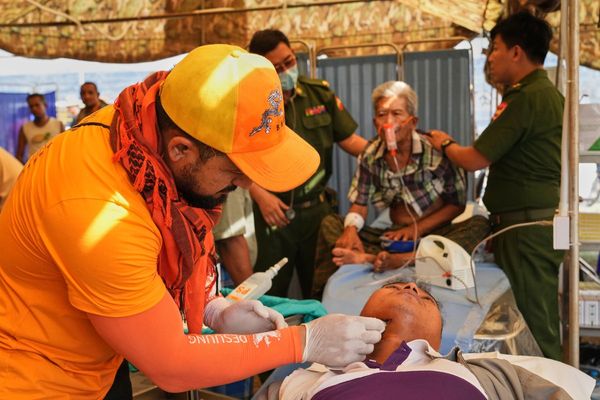Inside a gutted office block in Woden, ACT police were doing something they would usually never do: ignoring the pleas of help from victims.
People, lying on the ground and covered in what appeared to be blood, were grabbing at the legs of the police officers as the uniformed pair walked slowly and methodically through the building, their black Glock handguns trained at eye level, panning 180 degrees and their eyes alert to any emerging threat.
People were whimpering, frightened, cowering behind desks. Some appeared badly injured.
"Please help me," one victim implored.

But the shooter was still inside, somewhere, and the police had to find him. The injured had to wait; the threat inside the building remained, they had to keep moving.
The officers couldn't stop to render assistance, only provide short, sharply worded verbal updates via the radio on where the injured were and how many victims were thought to be inside, hiding and unable to escape.
Police couldn't risk send paramedics in while the shooter was still inside and walking about.
Two officers at a time were sent into the two-storey building as shots rang out from inside.
STAY TOGETHER
They were told that whatever happened in there, they were to stay together.
The most effective technique, as they had been trained, was that one officer was to lead, handgun out and held in the dominant and firing hand.
The non-dominant hand was to to be left free to use the police radio.

Time was critical; they had to move as quickly as possible, assess the danger, make the situation safe and clear the building.
Behind the lead officer, the second scanned for any possible approach from behind. Where possible, they walk side-by-side, one officer always watching the rear. In narrow spaces, they fall into single file, but always close together.
Guns are out and they head toward the sound of the shots. Some of the victims in hiding raise their heads above their desks to point directions to where they think the gunman had gone.
"Stay together, stay together, look around, look around, watch the back, watch the back," the message came over the police radio.
For first-on-scene police officers at an armed-offender-on-premises scene - particularly a large one like an office block - clearing the building starts at the bottom.
The patrol officers tasked with clearing the building would know the specialist "men in black" were on their way. However, every minute spent waiting for the heavily armed, body-armoured teams means that more people could be injured or killed by an offender known to be still moving inside the building.

So in the meantime someone, like NSW Inspector Amy Scott headed toward the offender at the Bondi Junction shopping plaza as the terrified patrons fled, has to step up.
LEARNING PROCESS
Active-shooter scenarios - or what the federal police call "immediate action rapid deployment training" - are now part of the learning process for every police officer in the country, and the Woden exercise - complete with volunteer actors covered in fake blood - was one developed for one of those rare but extremely challenging situations.
The Glocks were dummy handguns and there were observers inside the building to provide an "active debrief" to every pair of officers as they re-emerged, hearts racing and blinking with relief.
One long-serving ACT officer, who preferred not to be named, described it as "challenging, emotional and teaches you a different way of thinking and acting when it comes to an active and mobile attacker".
He said this training was "a big mental adjustment for many experienced police officers".
"It's challenging and takes a big mind shift to walk past people reaching out and crying for help to continue to move forward toward the threat," he said.
"Some of these people can be children, the elderly, and other people who are scared out of their wits and the only reassuring and safe presence is you, and you've got to leave them and move forward.
"The saying that 'police head towards danger while others run away' is what this training is all about.
"It's all about finding the active and mobile attacker and limiting the damage that person can do. Once the threat is gone, you can focus on preserving and saving life, securing the crime scene and the thousands of other jobs that will arise from such an incident."
STUDYING AN ENEMY
In preparing for the worst, police around the world have been studying active-shooter scenarios for years.
Years ago, police generally adopted the "cordon and contain" philosophy; get the uninvolved people away from the risk and out to safety, surround the building, bring in the negotiators and spend as long as necessary to convince the offender to surrender.
And this remains the most common practice in the majority of situations where an offender is barricaded in a building. If no lives are in danger, then the situation is manageable. A siege with hostages inside, such as Sydney's Lindt Cafe siege 10 years ago, has to be managed slightly differently.
"Cordon and contain" doesn't suit an armed, active offender moving through a building, intent on causing as much harm as possible because it puts more lives at risk.
So someone in police uniform - usually the first one on scene, and it could be a probationary constable - has to go in, not knowing what threat they face, with just a Glock, a stab-proof vest and a fellow officer to watch their back.
It's not a scenario for the faint-hearted.







